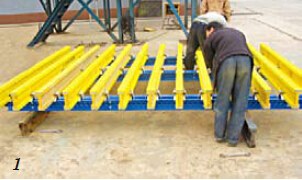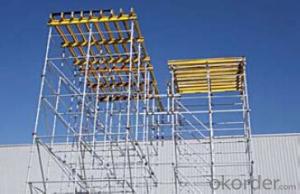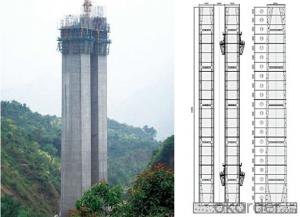Timber-Beam Plywood Formwork For building Construction
- Loading Port:
- Tianjin
- Payment Terms:
- TT OR LC
- Min Order Qty:
- 50 m²
- Supply Capability:
- 1000 m²/month
OKorder Service Pledge
Quality Product, Order Online Tracking, Timely Delivery
OKorder Financial Service
Credit Rating, Credit Services, Credit Purchasing
You Might Also Like
Plywood --- make perfect concrete surface
WISA-Form Birch is a coated special plywood using in the formwork systems where high
requirements are set on the concrete surface and the times of reuses.
With CNBM timber beam & WISA plywood, the formwork is low weight but high load capacity, it is
widely used in construction.
Characteristics:
◆ Component with high standardization.
◆ Assembling in site, flexible application.
◆ Light weight, easy transportation and storage.



- Q: What are the different types of accessories used with steel formwork?
- Some different types of accessories used with steel formwork include wedges, clamps, connectors, form ties, formwork braces, pins, and formwork release agents.
- Q: What are the common challenges faced during steel formwork installation?
- During steel formwork installation, one often encounters various common challenges. These challenges may differ depending on the specific project and site conditions. Here are some of the most prevalent challenges: 1. Precise alignment: Achieving accurate alignment of steel formwork panels can be difficult, particularly in large and intricate structures. It is crucial to ensure proper alignment for maintaining the stability and integrity of the formwork system. 2. Leveling and plumbing: Formwork must be level and plumb to ensure accurate concrete pouring as per the desired specifications. This task can be challenging, especially when working on uneven or sloping surfaces. 3. Formwork stability: To prevent movement or collapse during concrete pouring, steel formwork needs to be stable and securely anchored. Ensuring proper anchorage and stability can be challenging, particularly in areas with high wind loads or seismic activity. 4. Coordination of reinforcement placement: Installing steel formwork often involves coordinating with other trades, such as reinforcing steel installers. Challenges may arise in ensuring proper placement of reinforcement within the formwork, including sufficient clearance for concrete cover and appropriate spacing between bars. 5. Formwork removal: After the concrete has cured, the formwork needs to be removed without causing any damage to the concrete surface. This process can be challenging, especially when dealing with complex shapes or intricate details. 6. Reusability and maintenance: Steel formwork is designed to be reusable, but proper maintenance and care are necessary for its longevity. Challenges can arise in maintaining the formwork in good condition, especially when exposed to harsh weather conditions or rough handling. 7. Safety considerations: Steel formwork installation involves working at heights and handling heavy materials, which can pose safety risks. Challenges may include ensuring worker safety, implementing appropriate fall protection measures, and adhering to safety regulations and guidelines. In conclusion, steel formwork installation is a demanding and complex process that requires meticulous planning, coordination, and attention to detail. Overcoming these common challenges is vital for the successful completion of any construction project.
- Q: How does steel formwork handle different concrete pouring techniques?
- Steel formwork is a versatile and durable option for handling different concrete pouring techniques. Its strength and rigidity allow it to withstand the pressure exerted by various pouring methods, ensuring a stable and secure structure. One common pouring technique is the traditional gravity pouring, where concrete is poured into the formwork from the top and allowed to flow downwards due to its own weight. Steel formwork is well-suited for this method as it can easily contain the concrete and prevent any leakage or spillage. The formwork's tight joints and sturdy panels ensure that the concrete remains in place and is evenly distributed throughout the formwork. Another technique is the pumping method, where concrete is pumped into the formwork using specialized equipment. Steel formwork can handle this technique effectively as it can withstand the force and pressure exerted by the pumping process. The formwork's robust construction and reinforced edges provide the necessary support to contain the concrete and prevent any deformation or leakage. Steel formwork is also compatible with the slip-forming technique, which involves continuously pouring concrete into a moving formwork system. This method requires a formwork system that can be easily moved and adapted to changing shapes and heights. Steel formwork's modular design allows for quick and efficient adjustments, making it suitable for slip-forming applications. Additionally, its strength and stability ensure that the formwork remains intact during the continuous pouring process. In summary, steel formwork is a reliable choice for handling different concrete pouring techniques. Its strength, rigidity, and adaptability make it capable of withstanding the pressure and forces exerted by gravity pouring, pumping, and slip-forming methods. With steel formwork, builders and contractors can confidently execute various concrete pouring techniques, resulting in high-quality and structurally sound construction projects.
- Q: Can steel formwork be used in residential housing projects?
- Yes, steel formwork can be used in residential housing projects. Steel formwork is a versatile and durable option for construction, offering strength and stability to the structure. It allows for precise and efficient shaping of concrete, ensuring high-quality finishes in residential buildings. Additionally, steel formwork can be reused multiple times, making it a cost-effective choice for long-term projects.
- Q: Can steel formwork be used for marine construction projects?
- Marine construction projects can indeed utilize steel formwork. The durability of steel makes it suitable for enduring the challenging conditions of the marine environment, including exposure to saltwater, waves, and corrosive elements. By providing the necessary strength and stability, steel formwork can withstand the forces exerted in marine settings. Its versatility allows it to be utilized in various marine construction applications, such as the construction of seawalls, piers, jetties, and offshore structures. Furthermore, steel formwork offers numerous advantages, including easy assembly and disassembly, reusability, and the ability to create intricate shapes and structures. However, to ensure the long-lasting performance of steel formwork in marine environments, it is crucial to implement proper corrosion protection measures, such as galvanization or the use of anti-corrosive coatings.
- Q: What are the considerations when designing steel formwork for high-rise buildings?
- When designing steel formwork for high-rise buildings, it is important to consider several key factors: 1. Load-bearing capacity: High-rise buildings experience significant vertical and lateral loads. Therefore, the steel formwork must be able to support the weight of the concrete and any additional loads, such as equipment or workers. 2. Structural stability: The design of the steel formwork should ensure structural stability during the construction process. This involves considering factors like building height, wind loads, and the possibility of earthquakes. Proper bracing and reinforcement are necessary to maintain formwork stability. 3. Durability: High-rise buildings often have longer construction periods, so the formwork must be able to withstand prolonged exposure to concrete, weather conditions, and repetitive use. To enhance durability, the steel formwork should be designed with corrosion-resistant materials and protective coatings. 4. Flexibility and adaptability: High-rise buildings often have complex architectural designs and irregular shapes. Therefore, the formwork system should be flexible and adaptable to accommodate variations in geometry. This allows for efficient construction and minimizes the need for custom-made components. 5. Safety: Safety is of utmost importance when designing steel formwork for high-rise buildings. The formwork should be designed to prevent accidents and ensure the well-being of workers. Safety features such as guardrails, toe boards, and safe access points should be incorporated. 6. Ease of assembly and disassembly: Assembling and disassembling formwork for high-rise buildings can be labor-intensive and time-consuming. To streamline the construction process, the formwork system should have easy-to-use connections, standardized components, and clear assembly instructions. 7. Cost-effectiveness: High-rise construction projects often have limited budgets. Therefore, the design of the steel formwork should take into account its cost-effectiveness. This includes considering the potential for formwork reuse, minimizing the need for additional support structures, and optimizing the use of materials. By carefully considering these factors, designers can ensure that the steel formwork for high-rise buildings is strong, safe, durable, and cost-effective, enabling the successful construction of these complex structures.
- Q: Steel formwork in the construction project, after the completion of concrete pouring, the wall surface from the powder seriously how to deal with?
- This is no problem with the steel template, the ratio of concrete problems!
- Q: What are the different types of edge protection used with steel formwork?
- There are several types of edge protection used with steel formwork to ensure safety and prevent accidents on construction sites. Some of the common types include: 1. Edge protection barriers: These are typically made of a sturdy material like steel or aluminum and are installed along the edges of the formwork. They act as a physical barrier to prevent workers from accidentally falling off the edge. Edge protection barriers are often adjustable and can be easily installed and removed as needed. 2. Toe boards: Toe boards are typically made of wood or steel and are installed along the lower edge of the formwork. They provide a barrier to prevent tools, equipment, or debris from falling off the edge. Toe boards also serve as a visual indicator, reminding workers to be cautious near the edge. 3. Handrails: Handrails are horizontal bars that are attached to vertical posts and are installed along the edges of the formwork. They provide a secure handhold for workers, helping them maintain balance and stability, especially when working at heights. Handrails are often required by safety regulations in certain situations. 4. Safety nets: Safety nets are installed below the formwork to catch any falling objects or debris. They are typically made of high-strength mesh material and are designed to absorb the impact of a falling object. Safety nets are useful when there is a risk of objects falling off the edge, such as during concrete pouring or during the removal of formwork. 5. Harnesses and lifelines: In certain high-risk situations, workers may be required to wear harnesses and use lifelines to protect themselves from falling. These systems consist of a harness that is worn by the worker and connected to a lifeline, which is securely anchored to a structure. Harnesses and lifelines provide an additional layer of protection in situations where edge protection alone may not be sufficient. It is important to note that the choice of edge protection will depend on the specific requirements of the project, local regulations, and the level of risk associated with the work being performed. It is crucial for construction companies to assess the site conditions and implement appropriate edge protection measures to ensure the safety of workers.
- Q: How does steel formwork prevent concrete spillage?
- To prevent concrete spillage, steel formwork is utilized as it provides a sturdy and inflexible framework. This framework effectively contains and secures the concrete in position throughout the pouring and curing stages. To ensure that the concrete does not escape, the steel formwork is meticulously designed with seamless joints and a smooth surface, leaving no room for gaps or leaks. Consequently, any potential spillage or leakage during the pouring process is avoided. Furthermore, the strength and stability of steel formwork are often enhanced by incorporating internal bracing or supports. This reinforcement fortifies the formwork, preventing any movement or distortion, and ensuring it maintains its intended shape and position. Consequently, the steel structure acts as a barrier, preventing the concrete from spilling or overflowing. In addition, steel formwork is typically constructed with securely connected vertical sides and bottom plates. This specific configuration establishes an effective containment system that securely holds the concrete in place, preventing it from flowing out or penetrating any crevices. The snug fit of the formwork also aids in achieving the desired shape and dimensions of the cast concrete structure. In conclusion, steel formwork is a dependable and sturdy solution to prevent concrete spillage. Its strength, rigidity, and seamless joints guarantee that the concrete is contained within the desired area, significantly minimizing the risk of spillage or leakage during the construction process.
- Q: How does steel formwork handle architectural features such as openings and recesses?
- Steel formwork is a highly versatile and customizable solution that can easily handle architectural features such as openings and recesses. With its strength and flexibility, steel formwork can be shaped and adjusted to accommodate various shapes and dimensions, ensuring a precise fit. This allows for the creation of openings, recesses, or any other architectural feature required in the construction process. Additionally, steel formwork can be easily dismantled and reused, making it a cost-effective and efficient choice for handling complex architectural designs.
Send your message to us
Timber-Beam Plywood Formwork For building Construction
- Loading Port:
- Tianjin
- Payment Terms:
- TT OR LC
- Min Order Qty:
- 50 m²
- Supply Capability:
- 1000 m²/month
OKorder Service Pledge
Quality Product, Order Online Tracking, Timely Delivery
OKorder Financial Service
Credit Rating, Credit Services, Credit Purchasing
Similar products
Hot products
Hot Searches
Related keywords




















